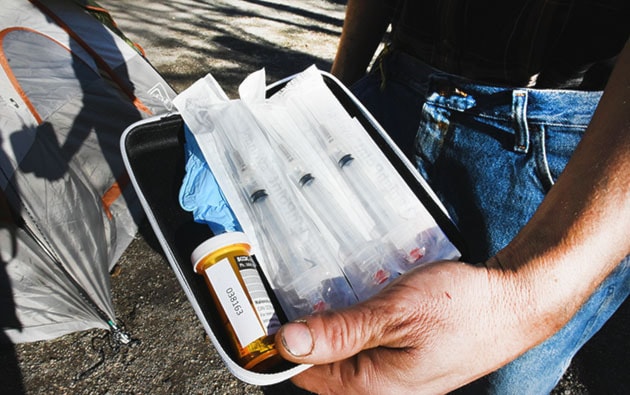A coroner's inquest jury has issued 21 recommendations to try to reduce the toll from illicit drug deaths in B.C.
The recommendations focus on improved treatment options for those struggling with drug dependency issues, including: Better access to the opioid replacement therapy Suboxone; expansion of treatment programs and beginning overdose prevention education in elementary schools.
EXTRA: BC calls on feds for emergency help
Chief Coroner Lisa Lapointe thanked Presiding Coroner Michael Egilson and the five-person jury for their work throughout the eight days of the inquest.
"These thoughtful and thorough recommendations show the value of the inquest process in which a key social issue, such as the growing number of illicit drug deaths, can be explored from a variety of angles to provide a context from which a jury can make such excellent recommendations," she said.
Other recommendations centre on the need for appropriate transition planning when those who suffer from drug dependency are released from custody.
The jury was looking into the death of Brandon Juhani Jansen aged 20, of Coquitlam, who died while a resident at a substance abuse treatment centre in Powell River in the early morning hours of March 7, 2016.
The jury found that Mr. Jansen died from "a mixed opioid drug overdose", and classified his death as accidental.
Coroner's jury recommendations are not binding. Here is the complete list:
1. Develop specific substance use treatment facility regulations under the Community Care and Assisted Living Act, including with respect to educational qualifications for persons working in such facilities.
2. Ensure free opioid maintenance drugs in the community for people leaving correction centres.
3. Review the need for increasing the number of supervised consumption sites rather than overdose prevention sites.
4. Explore options to create a shared database for the treatment of substance abuse to include medical, psychiatric, criminal and substance abuse treatment records.
5. Explore options for critical incident information sharing with respect to unexpected deaths in substance use facilities among licensees and Health Authorities with the goal of enhancing client safety and risk prevention.
6. Develop standards of practice for treating persons with opioid addictions.
7. Provide, develop and improve adolescent substance abuse treatment facilities.
To: The Minister of Health and CEOs of Regional Health Authorities
8. Consult with persons with lived experience with substance use dependency in policy and program development.
To: The CEOs of Regional Health Authorities:
9. Require all substance use treatment centres to educate clients with opioid use disorders about opioid maintenance treatments, the risks of relapse, ensure the understanding of tolerance levels, training for the use of naloxone, and provision of naloxone kits upon discharge.
10. Require all substance use treatment programs to report back to health authorities on client outcomes.
11. Provide opioid dependent users ready access to opioid replacement interventions.
12. Expand diacetylmorphine and hydromorphone treatment programs for chronic opioid users
To: The Minister of Public Safety and Solicitor General:
13. Develop a standard of practice for inmate community release, including the requirement that inmates on opioid maintenance treatment are assigned to community physicians capable of treating them. Inmates also need the ability to apply for social assistance and housing prior to release.
To: The Minister of Education:
14. Conduct a review of approved drug education resources in line with current evidence based research. Implement into the education curriculum a substance abuse and addiction program, starting at the elementary level by giving the teachers the resources and tools needed.
15. Have Noloxone kits available in the school system with trained personal on site.
To: The Director of the BC Centre on Substance Use:
16. Embark on comparative research of substance use treatment modalities with the goal of determining the features that lead to better client outcomes.
To: The Registrar of the College of Physicians and Surgeons of British Columbia
To: The Chair of the British Columbia Medical Association
To: The Board Chair of the College of Regi stered Nurses of British Columbia, and
To: The President of the British Columbia Nurse Practitioner Association
17. Ensure membership is aware that Suboxone is a first line treatment option for opioid use disorder, as well as the risks and benefits of Suboxone relative to methadone.
To: The CEO Sunshine Coast Health Centre
18. Review security procedures and training with all staff.
To: The CEO all Licensed Substance Use Treatment Centres
19. Review guidelines regarding cell phone / Electronic device polices.
20. Ensure all baggage is searched on entering the facility including clients and visitors.
21. Consider greater security measures for monitoring clients and visitors. e.g.- Fob System for door; - Video System
